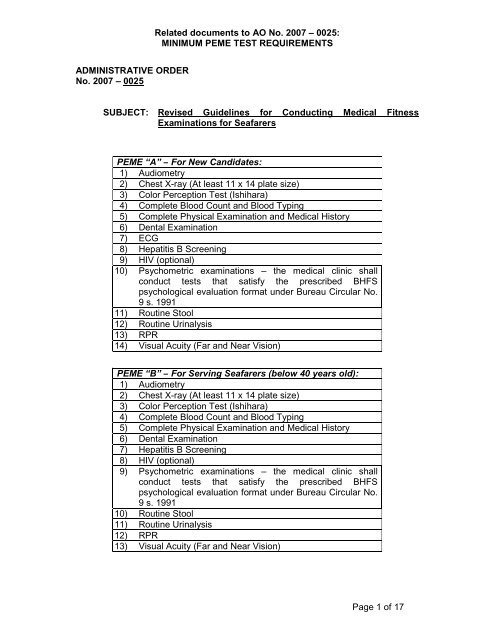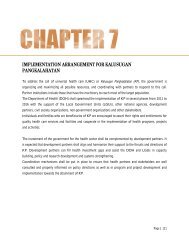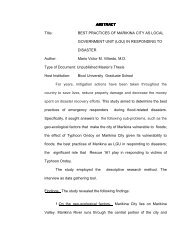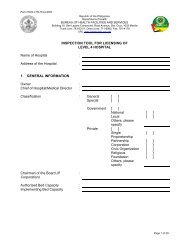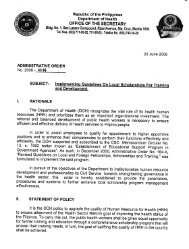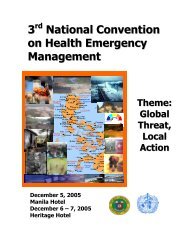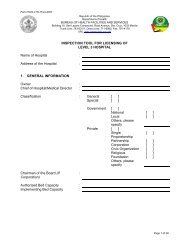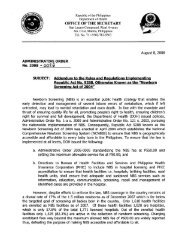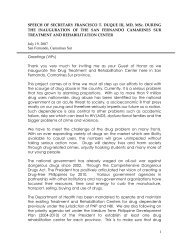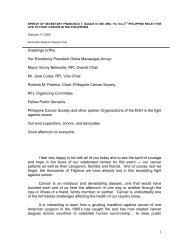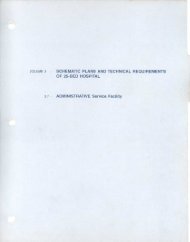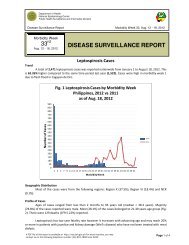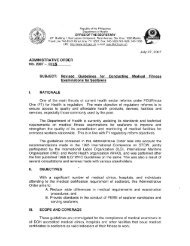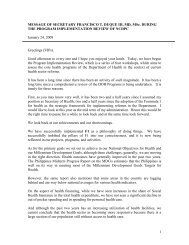Related Documents and Requirements - DOH
Related Documents and Requirements - DOH
Related Documents and Requirements - DOH
You also want an ePaper? Increase the reach of your titles
YUMPU automatically turns print PDFs into web optimized ePapers that Google loves.
<strong>Related</strong> documents to AO No. 2007 – 0025:MINIMUM PEME TEST REQUIREMENTSADMINISTRATIVE ORDERNo. 2007 – 0025SUBJECT: Revised Guidelines for Conducting Medical FitnessExaminations for SeafarersPEME “A” – For New C<strong>and</strong>idates:1) Audiometry2) Chest X-ray (At least 11 x 14 plate size)3) Color Perception Test (Ishihara)4) Complete Blood Count <strong>and</strong> Blood Typing5) Complete Physical Examination <strong>and</strong> Medical History6) Dental Examination7) ECG8) Hepatitis B Screening9) HIV (optional)10) Psychometric examinations – the medical clinic shallconduct tests that satisfy the prescribed BHFSpsychological evaluation format under Bureau Circular No.9 s. 199111) Routine Stool12) Routine Urinalysis13) RPR14) Visual Acuity (Far <strong>and</strong> Near Vision)PEME “B” – For Serving Seafarers (below 40 years old):1) Audiometry2) Chest X-ray (At least 11 x 14 plate size)3) Color Perception Test (Ishihara)4) Complete Blood Count <strong>and</strong> Blood Typing5) Complete Physical Examination <strong>and</strong> Medical History6) Dental Examination7) Hepatitis B Screening8) HIV (optional)9) Psychometric examinations – the medical clinic shallconduct tests that satisfy the prescribed BHFSpsychological evaluation format under Bureau Circular No.9 s. 199110) Routine Stool11) Routine Urinalysis12) RPR13) Visual Acuity (Far <strong>and</strong> Near Vision)Page 1 of 17
<strong>Related</strong> documents to AO No. 2007 – 0025:MINIMUM PEME TEST REQUIREMENTSPEME “C” – For Serving Seafarers (40 years old <strong>and</strong>above):1) Audiometry2) Blood Uric Acid3) Chest X-ray (At least 11 x 14 plate size)4) Color Perception Test (Ishihara)5) Complete Blood Count6) Complete Physical Examination <strong>and</strong> Medical History7) Creatinine8) Dental Examination9) ECG10) Fasting Blood Sugar11) Hepatitis B Screening12) HIV (optional)13) Psychometric examinations – the medical clinic shallconduct tests that satisfy the prescribed BHFSpsychological evaluation format under Bureau Circular No.9 s. 199114) Routine Stool15) Routine Urinalysis16) RPR17) Total Cholesterol18) Triglyceride19) Visual Acuity (Far <strong>and</strong> Near Vision)PEME “D” – For Food H<strong>and</strong>lers:1) PEME “A”, “B”, or “C”, as appropriate2) Stool Culture (optional)Page 2 of 17
<strong>Related</strong> <strong>Documents</strong> to AO No. 2007 – 0025:FORMAT OF THE PEME CERTIFICATION FOR SEAFARERSGo to www.doh.gov.phDoing Business with <strong>DOH</strong>Licensing<strong>Requirements</strong> for Licensing of Health Facilities <strong>and</strong> ServicesMedical Facility for Overseas Workers <strong>and</strong> SeafarersTEMPLATE OF PEME CERTIFICATEPage 3 of 17
<strong>Related</strong> <strong>Documents</strong> to AO No. 2007 – 0025:INSTRUCTIONS TO ACCREDITED MEDICAL CLINICSA. Checklist for the Medical Examiner1. Check the identity of the person to be examined, note his valid IdentificationCard (e.g. Seaman’s Book, NBI Clearance, SSS ID, Company ID, Driver’s ID,PRC ID, Voter’s ID, Passport), <strong>and</strong> record accurately the number on hisPEME form.2. Check the examinee’s previous medical records (if available <strong>and</strong> necessary).3. Collect information on previous medical history. Ask point-by-point for detailsof diseases or injuries, tick the respective boxes on the form, <strong>and</strong> add furtherdetails if the examinee reports diseases or injuries. Note tobacco use <strong>and</strong> thenumber of cigarettes smoked per day. Note alcohol intake. After collectingthese data, the examinee signs the form certifying it is a true statement.4. Measure <strong>and</strong> record the weight, pulse rate <strong>and</strong> blood pressure. Perform thephysical examination <strong>and</strong> record the results. Check the results of laboratory,ECG, chest x-ray <strong>and</strong> other examination if necessary. Record the results onthe form.5. Check hearing, eyesight <strong>and</strong> color vision. Record the results on the form.6. Evaluate the results of the examination. Assess the fitness of the seafarer forsea duty <strong>and</strong> for the specified job on board.7. If the examinee is found fit for sea duty, issue the Fit PEME Certificate.8. If the examinee is found temporarily unfit for sea duty, explain to him thereasons during follow-up visit. Advise him to undergo additional test/s, referhim appropriately to an accredited specialist or to undergo the necessarytreatment as may be necessary within thirty (30) days from date of initialPEME.9. After checking the vaccination record of the examinee, advise on obligatory<strong>and</strong> voluntary immunization that will protect him from infectious diseases (e.g.hepatitis, poliomyelitis, tetanus).10. If necessary <strong>and</strong> time permits, encourage the examinee to modify his lifestyle(e.g. limit alcohol intake, stop smoking, lose weight).B. Important Information1. Printed health education materials (e.g. information booklets on HIV/ AIDSprevention, smoking cessation) may be distributed to seafarers in accreditedmedical clinics.2. For seafarers employed on chemical bulk carrier, additional blood tests shallbe required as part of the PEME test requirements.3. Audiometric test shall form part of the PEME test requirements for allseafarers.4. ECG shall be done before sea duty <strong>and</strong> shall form part of the periodic PEMEfor seafarers aged 40 years old <strong>and</strong> above.5. In the fitness assessment for a specific job, the medical examiner shall makeuse of the job description in the Seafarers’ Training, Certification <strong>and</strong>Watchkeeping Code <strong>and</strong> the M<strong>and</strong>atory St<strong>and</strong>ards <strong>and</strong> RecommendationGuidance of the Maritime Safety Committee.6. Full clinical notes <strong>and</strong> results of PEME shall be kept in the record section ofthe clinic following a minimum record retention of three (3) years.7. The cadet seafarer may request a copy of his Fit PEME Certificate from hisagency.8. The PEME of seafarers are conducted in accordance with internationallyratified conventions. The Fit PEME Certificate shall certify that the hearing,Page 4 of 17
<strong>Related</strong> <strong>Documents</strong> to AO No. 2007 – 0025:INSTRUCTIONS TO ACCREDITED MEDICAL CLINICSsight <strong>and</strong> color vision of the seafarer are satisfactory, <strong>and</strong> that he is notsuffering from any disease likely to be aggravated by or render him unfit forsea duty, or to endanger the health of the crew <strong>and</strong> passengers.9. If the validity period of the Fit PEME Certificate expires during the course of avoyage, the certificate shall continue to be valid until the end of that voyage.10. The Fit <strong>and</strong> Temporarily Unfit PEME Certificate shall be issued to themanning agency. All pending for both completion of PEME <strong>and</strong> completion ofprescribed additional tests shall be reported properly to the manning agency.After the specified period lapses, the Pending PEME Certificate shall bestamped ‘Unfinished’ <strong>and</strong> delivered to the manning agency with the billingstatement.11. No ‘Light Duty’ is available.C. Minimum In-Service Eyesight St<strong>and</strong>ards:Category ofSeafarerNewC<strong>and</strong>idatesCadets (Deck<strong>and</strong> Engine)Distant VisionOneEyeAided 20/20(1.0)Unaided 20/30(0.66)Deck Officers/RatingsPerformingDeckWatchkeepingDutiesAided 20/20(1.0)Unaided 20/100(0.2)OtherEye20/20(1.0)20/30(0.66)20/40(0.5)20/100(0.2)NearImmediateVisionBoth EyesAided orUnaidedVisionrequired forship’snavigation(e.g. chart<strong>and</strong> nauticalpublicationreference,use ofbridgeequipment,identificationof aids tonavigation)Visionrequired forship’snavigation(e.g. chart<strong>and</strong> nauticalpublicationreference,use ofbridgeequipment,identificationof aids tonavigation)ColorVisionNormal(Ishihara)Normal(Ishihara)VisualFieldNormalNormalNightBlindnessVisionrequired toperform allnecessaryfunctions indarknesswithoutcompromiseVisionrequired toperform allnecessaryfunctions indarknesswithoutcompromiseDiplopia(DoubleVision)NosignificantconditionevidentNosignificantconditionevidentPage 5 of 17
<strong>Related</strong> <strong>Documents</strong> to AO No. 2007 – 0025:INSTRUCTIONS TO ACCREDITED MEDICAL CLINICSCategory ofSeafarerEngineOfficers/RatingsPerformingEngineWatchkeepingDutiesDistant VisionOneEyeAided 20/30(0.66)Unaided 20/100(0.2)ServiceProviders(HousekeepingManagers,Supervisors,Bartenders,Entertainers,Waiters/Waitresses,CabinAttendants,etc.)OtherEye20/50(0.4)20/100(0.2)NearImmediateVisionBoth EyesAided orUnaidedVisionrequiredreadinginstrumentin closeproximity tooperateequipment<strong>and</strong> identifysystems/componentsasnecessary.ColorVisionAble todistinguishthe colorsred,yellow <strong>and</strong>greenVisualFieldSufficientNightBlindnessVisionrequired toperform allnecessaryfunctions indarknesswithoutcompromiseSufficient Sufficient Sufficient Visionrequired toperform allnecessaryfunctions indarknesswithoutcompromiseDiplopia(DoubleVision)NosignificantconditionevidentNosignificantconditionevidentAided 20/30(0.66)Unaided 20/200(0.1)20/70(0.28)20/200(0.1)Page 6 of 17
<strong>Related</strong> <strong>Documents</strong> to AO No. 2007 – 0025:JOB REQUIREMENTS AND FITNESS STANDARDSAssessment of a seafarer’s fitness shall be of most use when the medical examinerknows as much about the job on board the ship as about the individual beingassessed. The physical dem<strong>and</strong>s of a job are defined in the following terms:strength, climb <strong>and</strong> balance, stoop, kneel, crouch <strong>and</strong> crawl, reach, h<strong>and</strong>le, touch<strong>and</strong> feel, talk <strong>and</strong> hear, <strong>and</strong> visual acuity (distant vision, near vision, color vision,visual field).In the fitness assessment for a specific job, the medical examiner shall make use ofthe job description in the Seafarers’ Training, Certification <strong>and</strong> Watchkeeping Code<strong>and</strong> the M<strong>and</strong>atory St<strong>and</strong>ards <strong>and</strong> Recommendation Guidance of the MaritimeSafety Committee, <strong>and</strong> the physical capabilities based on shipboard tasks, functions,events or conditions.Guidance on Assessment of Minimum Entry-Level <strong>and</strong> In-Service PhysicalAbilities for SeafarersShipboard Task, Function,Event or ConditionRoutine movement on slippery,uneven <strong>and</strong> unstable surfacesRisk of injuryRoutine access between levelsEmergency responseproceduresRoutine movement betweenspaces <strong>and</strong> compartmentsEmergency responseproceduresOpen <strong>and</strong> close watertightdoorsH<strong>and</strong> cranking systemsOpen <strong>and</strong> close valve wheelsH<strong>and</strong>le linesUse h<strong>and</strong> tools e.g. spanners,fire axes, valve wrenches,hammers, screwdrivers, pliersAccess throughout shipUse tools <strong>and</strong> equipmentEmergency responseprocedures e.g. donning of lifejacket or response suitH<strong>and</strong>le ship’s store roomUse tools <strong>and</strong> equipmentH<strong>and</strong>le linesEmergency responseproceduresOverhead storageOpen <strong>and</strong> close valve wheels<strong>Related</strong> Physical AbilityMaintain balance/ equilibriumClimb up <strong>and</strong> down vertical/inclined ladders <strong>and</strong> stairwaysStep over coamings e.g. up to60 cm in heightManipulate mechanical devices(manual <strong>and</strong> digital dexterity<strong>and</strong> strength)Move with agilityLift, pull <strong>and</strong> carry loadReach above shoulder heightThe Medical Examiner ShouldEnsure that the C<strong>and</strong>idateHas no disturbance in sense ofbalanceIs able without assistance toclimb up <strong>and</strong> down vertical/inclined ladders <strong>and</strong> stairwaysIs able to grasp, lift <strong>and</strong>manipulate various commonshipboard tools; move h<strong>and</strong>s/arms to open <strong>and</strong> close valvewheels in vertical <strong>and</strong> horizontaldirections; rotate wrists to turnh<strong>and</strong>lesIs able to grasp, lift <strong>and</strong>manipulate various commonshipboard tools; move h<strong>and</strong>s/arms to open <strong>and</strong> close valvewheels in vertical <strong>and</strong> horizontaldirections; rotate wrists to turnh<strong>and</strong>lesRequired range of motion is 90degreesDoes not have any impairmentor disease that can preventnormal movement <strong>and</strong> physicalactivityDoes not have any impairmentor disease that can preventnormal movement <strong>and</strong> physicalactivityDoes not have any impairmentor disease that can preventnormal movement <strong>and</strong> physicalactivityPage 7 of 17
<strong>Related</strong> <strong>Documents</strong> to AO No. 2007 – 0025:JOB REQUIREMENTS AND FITNESS STANDARDSShipboard Task, Function,Event or ConditionGeneral ship maintenanceEmergency responseprocedures e.g. damage controlEmergency responseprocedures e.g. escaping fromsmoke-filled spacesSt<strong>and</strong> watch for a minimum of 4hoursAccess between spacesEmergency responseproceduresReact to visual alarms,warnings <strong>and</strong> instructionsEmergency responseproceduresReact to audible alarms,warnings <strong>and</strong> instructionsEmergency responseproceduresMake verbal reportsCall attention to suspicious oremergency conditions<strong>Related</strong> Physical AbilityCrouch (lowering height bybending knees)Kneel (placing knees onground)Stoop (lowering height bybending at the waist)Crawl (ability to move the bodywith h<strong>and</strong>s <strong>and</strong> knees)Feel (ability to h<strong>and</strong>le or touchin order to examine ordetermine differences intemperature)St<strong>and</strong> <strong>and</strong> walk for extendedperiodWork in constricted spaces <strong>and</strong>move through restrictedopenings e.g. 60 cm by 60 cmDistinguish an object or shapeat a certain distanceHear a specified dB sound at acertain distanceDescribe immediatesurroundings <strong>and</strong> activities;pronounce words clearlyThe Medical Examiner ShouldEnsure that the C<strong>and</strong>idateDoes not have any impairmentor disease that can preventnormal movement <strong>and</strong> physicalactivityDoes not have any impairmentor disease that can preventnormal movement <strong>and</strong> physicalactivityIs able to st<strong>and</strong> <strong>and</strong> walk forextended periodDoes not have any impairmentor disease that can preventnormal movement <strong>and</strong> physicalactivityFulfills the eyesight st<strong>and</strong>ardsFulfills the eyesight st<strong>and</strong>ardsIs capable of normalconversationPage 8 of 17
<strong>Related</strong> <strong>Documents</strong> to AO No. 2007 – 0025:MEDICAL STANDARDS IN THE CONDUCT OF PEME FOR SEAFARERSThese medical guidelines are intended to allow the maximum flexibility ininterpretation that is compatible with the paramount aim in maintaining the safety ofseafarers at sea in the performance of their duties <strong>and</strong>, at the same time, protectingtheir health, the health of their fellow crew members <strong>and</strong> passengers on board.The list of medical conditions cited below per System Classification are mereexamples which may render a seafarer unfit. These can also be used to justifyrestrictions on time, position, trade area or type of vessels. It can only provideguidance for all examining physicians <strong>and</strong> shall never replace a sound medicaljudgment. Also, it may be used with other endorsed medical-related st<strong>and</strong>ards set byTrade Associations, Maritime Directorates, P <strong>and</strong> I Club or Principals/ Employers.A. INFECTIOUS DISEASESThere shall be no active infectious disease. Any infectious disease in itscommunicable or carrier state shall not present as a health hazard to other crewmembers by casual contact. It shall not pose as a medical risk in the development ofa debilitating condition while seafarer is serving his contract term. Post-treatmentevaluation of infectious disease as well as periodic monitoring of carrier state may benecessary to check if condition shall be medically upgraded or downgraded followingcomplete assessment of its clinical significance by an accredited Infectious DiseaseSpecialist. Acquired Immune Deficiency Syndrome (AIDS) Enteritis Hepatitis Lice Malaria Scabies Schistosomiasis, unless cleared by a specialist Sexually Transmitted Disease Tinea, active Tuberculosis 1o Newly diagnosed cases until full treatment course is done, or clearance by anaccredited chest specialist or infectious disease specialist is grantedo Radiological findings of PTB, less than one (1) year stability for newlydiagnosed cases with recent record of treatment (within one year). Temporaryunfitness of disclosed cases may be upgraded when the examining physicianis satisfied on the advice of an accredited Chest Specialist that the PTB lesionis fully healed, stable, <strong>and</strong> inactive as evidenced by satisfactory comparativechest x-ray review/s <strong>and</strong> negative AFB smears, including record of completedfull treatment course.o Cases where either one or both lungs are infected i.e. moderately advancedto far advanced PTBo Extra-pulmonary tuberculosis, which include Miliary TB, Scrofula <strong>and</strong> RenalTB Typhoid carrier within a year from infection is not acceptable for food h<strong>and</strong>lers,unless cleared by a specialist.1 Clearance may depend upon host country guidelinesPage 9 of 17
<strong>Related</strong> <strong>Documents</strong> to AO No. 2007 – 0025:MEDICAL STANDARDS IN THE CONDUCT OF PEME FOR SEAFARERSB. MALIGNANT NEOPLASMThere shall be neither finding nor suspected finding of neoplasm at the time of preemploymentmedical examination. Significant history of any type of malignancy fornew c<strong>and</strong>idates is medically disqualifying. Exception may be appropriate for servingcrew members after complete course of treatment. Final evaluation before anyfitness recommendation shall consider prognosis of the disease, rate of recurrence,effect of the disease on job performance <strong>and</strong> the need for subsequent monitoring.C. ENDOCRINE, NUTRITIONAL AND METABOLIC CONDITIONS ANDIMMUNITY DISORDERSThere shall be no endocrine, nutritional, metabolic <strong>and</strong> immunity disorders present inall c<strong>and</strong>idates. When these disorders are present in serving seafarers, furtherinvestigation <strong>and</strong> complete assessment shall be done before any recommendation ismade. Acromegaly Acute Gouty Arthritis <strong>and</strong> Hyperuricemia Adrenal Insufficiency, uncontrolled BMI of less than 18 Cases undergoing Immunosuppressive Therapy Diabetes Mellitus, requiring insulin Hyperthyroidism, Toxic Diffuse Goiter, Toxic Nodular Goiter, Thyrotoxicosis,Thyroiditis Obesity, incapacitating or Body Mass Index of 34 <strong>and</strong> above with or without comorbidpre-existing conditions Osteoporosis Pheochromocytoma Uncontrolled cases of Diabetes Mellitus Type II Persistent abnormal liver or kidney test resultsD. DISEASES OF THE BLOOD AND BLOOD FORMING ORGANSThere shall be no significant hematological condition that requires treatment wheremedication causes immunosuppression, work interruption, <strong>and</strong> periodic monitoring toensure continuing fitness in the work place.Any abnormal condition requiring treatment that will inhibit or increase bloodcoagulationBleeding <strong>and</strong> Clotting DisordersMalignancies of the blood <strong>and</strong> blood forming organsMyelodysplasiaPersistent asymptomatic or unexplained anemia, where hemoglobin level isbelow 10 g/dl among females <strong>and</strong> below 12 g/dl among males, until satisfactoryinvestigation or treatment is donePolycythemiaSplenomegalyPage 10 of 17
<strong>Related</strong> <strong>Documents</strong> to AO No. 2007 – 0025:MEDICAL STANDARDS IN THE CONDUCT OF PEME FOR SEAFARERSE. MENTAL DISORDERSThere shall be no manifestation of any anxiety, depressive, psychotic, personality<strong>and</strong> psychological disorders identified <strong>and</strong> observed during the conduct of PEME<strong>and</strong> psychological testing. Appropriate psychologist’s or psychiatrist's evaluationshall be sought to determine if condition renders a seafarer permanently unsuitablefor seafaring duties.Active alcohol or drug dependence as evidenced by diagnostic test result/s <strong>and</strong>confirmatory drug test result including physical finding or identified relatedbehavioral disorderAcute Psychosis, whether organic, schizophrenic or any other listed in theInternational Classification of DiseasesDementia/ SenilityDepression, active requiring medicationHistory of documented mental disorder (psychosis)Identified "phobias" which will not fit into the job requirementObservation of Acute Manifestation of a Psychiatric Disorder that indicates aneed for psychiatric evaluationPersonality DisorderPsychoneurosis, Major Depression or ManiaF. CONDITIONS OF THE NERVOUS SYSTEM AND SENSE ORGANSThere shall be no existing manifestation of an acute or chronic neurological orsensory disorder. Any significant past history of such condition/s that may recur orlimit functional capacity to perform sea duties <strong>and</strong> require medical care or periodicmonitoring such as but not limited to the following should be carefully assessed.Conditions of the Nervous System: Ataxia, active (unsteadiness of Gait) Impairment of the Central Nervous System Function resulting from secondary oractive medical disorders e.g. Diabetes, Toxic Reaction, <strong>and</strong> Thyroid Disorder Migraine, frequent attacks causing incapacity Narcolepsy or Sleep Disorders resulting to unpredictable drowsiness whenindividual is awake Post -Concussion Syndrome, Active Seizure Disorder Secondary to structural abnormality, epilepsy, alcohol or drugwithdrawal or metabolic disorder Stroke Syncope <strong>and</strong> other disturbances of consciousness Tremors, active, interfering with the fine motor functions Vertigo, central or peripheral in originConditions of the Sense Organs: Cholesteatoma until successful surgical intervention Chronic Mastoiditis of both ears Chronic Otitis Media Chronic Sinusitis until successful surgical intervention Frequent EpistaxisPage 11 of 17
<strong>Related</strong> <strong>Documents</strong> to AO No. 2007 – 0025:MEDICAL STANDARDS IN THE CONDUCT OF PEME FOR SEAFARERSHearing Loss, sudden or progressive, sufficient to interfere with communication<strong>and</strong> or affecting work function (For catering positions, use of hearing aid may beallowed)Hypertrophied Tonsils or Laryngeal Cyst causing obstruction <strong>and</strong> or requiringsurgeryLaryngeal Cyst causing obstructionLaryngeal TumorMeniere's DiseaseNasal Polyp/sOtosclerosis with moderate hearing impairment (for positions with criticalwatchkeeping functions)G. CONDITIONS OF THE CARDIOVASCULAR SYSTEMThere shall be no acute or chronic cardiovascular condition limiting physical activityrequired for sea duties, requiring more than two (2) maintenance oral medicines <strong>and</strong>close monitoring, or causing significant disability.Abnormal TST result or terminated Treadmill Stress Test, the reason for suchtermination is clinically significantAll Rheumatic Heart ConditionsAngina Pectoris, currentAortic Aneurysm, currentArrhythmia, significant unless granted cardiac clearanceClaudication, currentConditions requiring anticoagulant maintenance medicationsCongenital Heart Disease (ASD, VSD <strong>and</strong> PDA) unless with history of completesurgical correction <strong>and</strong> recent clearance from an accredited cardiologistCongestive Heart FailureCoronary Artery Disease (CAD)Coronary Angioplasty (within six months), with history of AMI, left ventricularsystolic dysfunction, uncontrolled Diabetes Mellitus, Hypertension <strong>and</strong>DyslipidemiaCoronary By Pass (within six months), with co-morbid illness such as leftventricular systolic dysfunction, AMI, uncontrolled DM, Hypertension <strong>and</strong>Dyslipidemia (re-evaluation <strong>and</strong> clearance from an accredited cardiologist beforeany possible medical upgrade to fitness)ECG finding of Complete BBB <strong>and</strong> WPW unless cleared by an accreditedcardiologistECG finding of old MI, 2nd <strong>and</strong> 3rd degree AV BlockHypertension – Uncontrolled Hypertension, 140/90 <strong>and</strong> aboveo Hypertension requiring three (3) or more drugsHypertension with associated clinical conditions such as but not limited to:o Cerebrovascular Disease (Stroke, TIA)o Heart Disease (LVH, Ischemic Heart Disease, prior MI, priorrevascularization)o Non-Essential Hypertension to include renal or Hypertensive Nephrosclerosisor any Secondary Hypertensiono Obesity <strong>and</strong> Metabolic Syndromeo Poorly controlled Diabetes Mellitus or complicated Diabetes MellitusPage 12 of 17
<strong>Related</strong> <strong>Documents</strong> to AO No. 2007 – 0025:MEDICAL STANDARDS IN THE CONDUCT OF PEME FOR SEAFARERSo Renal Disease (persistent hematuria, proteinuria, <strong>and</strong> elevated creatinine)Ischemic Heart DiseaseMiscellaneous Heart Disease (MVP, Bicuspid Aortic Valve)Recent history (within 3 months) of Thrombophlebitis or PhlebothrombosisSyncope of Cardiac EtiologyValvular Heart Disease with Stenotic physiology accompanied by ChamberEnlargement or Hypertrophy (Mitral Stenosis, Aortic Stenosis, Pulmonic ValveStenosis)Varicose Veins, moderate to severe or with signs of stasis, ulcers or othercomplicationsH. CONDITIONS OF THE RESPIRATORY SYSTEMThere shall be no acute, chronic, pre-existing (per disclosed medical history),recurrent condition needing further investigation <strong>and</strong> full assessment, limiting workperformance on board/ workplace or causing significant disability.Abnormal radiological finding such as Residual Fibrosis, Calcifications suggestiveof PTB until satisfactory pulmonary clearance of an accredited chest specialistAtelectasis where FEV1/FVC is less than 60% (moderately impaired lungfunction) or FEV1 is less than 60% predicted valueBronchial Asthma 2 , with physical finding at time of examination or measured asmoderate Obstructive Lung Disease per Spirometry where FEV1/FVC is lessthan 70% with FEV1 less than 80% of predicted value or where conditionrequires systemic oral corticosteroid, continuing monitoring, observation, <strong>and</strong> hasthe likelihood for recurrence per accredited chest specialist's evaluationChronic Bronchitis or EmphysemaHistory of Pulmonary EmbolismModerate COPD where FEV1/FVC is less than 70% with FEV1 less than 80% ofthe predicted valueOther Lung Conditions such as finding of bullae, pneumothorax <strong>and</strong> the likewhich precludes air travel or that which could be seriously affected by it orconditions that predispose to barotraumasPneumothorax, spontaneous (secondary type)TumorsI. ORAL HEALTHThere shall be no mouth disease, gum infections <strong>and</strong> dental defects.J. CONDITIONS OF THE DIGESTIVE SYSTEMThere shall be no acute, chronic, or recurrent gastrointestinal disturbance affectingseafarer's function, requiring medication, <strong>and</strong> causing significant disability.Abscess, abdominal or peri-rectalAppendicitisBleeding, rectal2 Condition disqualifies new c<strong>and</strong>idatesPage 13 of 17
<strong>Related</strong> <strong>Documents</strong> to AO No. 2007 – 0025:MEDICAL STANDARDS IN THE CONDUCT OF PEME FOR SEAFARERSCholangitisCholecystitisCholelithiasis until successful surgeryChronic Active HepatitisDiarrhea, activeEsophageal VaricesGallbladder polyps (multiple)Gallbladder polyp, single, of significant size (1.8 cm), warranting surgical removalGastric or Intestinal UlcerationHemorrhoids with surgical indication for surgeryHepatic NoduleHepatitisHepatomegaly, significant <strong>and</strong> with concomitant liver enzyme elevationHistory of hematemesis within three monthsLiver CirrhosisMultiple Liver Cysts of Unknown etiologyPeptic ulcer in new c<strong>and</strong>idates. In the case of serving seafarers, those withproven ulceration shall not return to sea duty until free of symptoms. There shallbe proof of healing as evidenced by negative gastroscopy or endoscopy finding<strong>and</strong> the seafarers shall be on ordinary diet for at least three (3) months. Thosewith history of gastrointestinal bleeding, perforation, recurrent peptic ulceration(despite treatment). or complications after surgery shall remain unfit for sea duty.Peri-anal fistula <strong>and</strong> fissuresSchistosomiasisK. CONDITIONS OF THE GENITO-URINARY SYSTEMThere shall be no genito-urinary condition that would require periodic monitoring,surgical interventions, <strong>and</strong> prolonged treatment. Infectious conditions shall be fullytreated or controlled before resumption to sea duty.Active Venereal DiseaseBPH symptomatic, with moderate urinary retention <strong>and</strong> with positive PSAGynecological Conditions, acute or chronic which among others include abnormaluterine bleeding, PID, vaginal discharge suspected to be infectious in origin,pelvic mass by physical examination <strong>and</strong> vaginal wartsHernias unless successful surgical intervention <strong>and</strong> or surgical clearanceHydrocoele, large <strong>and</strong> recurrent until clearance from an accredited urologistIncontinence of urine, if irremediableNephritis, acute, sub-acute, or chronicPersistent proteinuria, glucosuria <strong>and</strong> other urinary abnormalitiesPolycystic KidneysProstatism with retentionRecurrent UTIRemoval of one kidney secondary to a pathological condition (congenitalabsence may be considered after clearance from an accredited KidneySpecialist)Renal Calculus until successful surgery or lithotripsyRenal Cyst(s) depending on the specialist’s discretion (nephrologist/ urologist)Symptomatic undescended testis with or without accompanying herniaPage 14 of 17
<strong>Related</strong> <strong>Documents</strong> to AO No. 2007 – 0025:MEDICAL STANDARDS IN THE CONDUCT OF PEME FOR SEAFARERSUrethral Discharge, activeUrinary Obstructions, if not remediableVaricocele, moderateL. PREGNANCYPregnancy shall disqualify all c<strong>and</strong>idates for seafaring duties.M. CONDITIONS OF THE MUSCULOSKELETAL SYSTEMThere shall be no musculoskeletal defect that could interfere with discharge ofseafarer's duties such as decrease in muscular power, loss of balance, mobility <strong>and</strong>lack of coordination. Limb prosthesis shall not be acceptable.Acute <strong>and</strong> chronic osteoarthritis, gouty arthritis with the following additional riskfactors:o Previous history of disability, repatriation reasonably affecting musculoskeletalfunctiono Presence of bone spurs <strong>and</strong> other related conditions that will limit workfunctiono Slipped disk, status post-laminectomy <strong>and</strong> other conditions requiring weightcarrying restrictions as a risk to safetyAny radiologic or orthopedic specialist's finding of moderate to severe Scoliosis(for serving crew members, careful re-evaluation shall be made in relation to jobfunctions)History of receiving disability recommendation for a significant medical conditionor work-related injuryLimb atrophy secondary to PoliomyelitisMuscular Atrophies, Dystrophies <strong>and</strong> related disordersSlipped disk by MRI if symptomaticStatus Post-Laminectomy within one yearRadiologic finding of Lumbar Instability until full accredited orthopedic surgeon'sevaluation <strong>and</strong> clearanceN. CONDITIONS OF THE SKINThere shall be no active communicable skin disease or recurrent skin diseaserefractory to medical management that poses a threat to seafarer's health, health ofother crew members on board or ship's passengers. Also, careful assessment ofexposure to substances which may act as irritants including job functions shall betaken into account in determining if seafarer is fit to resume sea duties.Acute <strong>and</strong> recurrent Eczema, Atopic Dermatitis <strong>and</strong> related conditionsAcute skin infection until satisfactory treatmentFolliculitis, carbuncles, abscesses until I <strong>and</strong> D <strong>and</strong> antibiotic therapyGeneralized Tinea, activeLeprosyMultiple Viral Warts until successful cautery <strong>and</strong>/ or managementPersistent Contact <strong>and</strong> Irritant DermatitisSevere Pustular Cystic AcnePage 15 of 17
<strong>Related</strong> <strong>Documents</strong> to AO No. 2007 – 0025:MEDICAL STANDARDS IN THE CONDUCT OF PEME FOR SEAFARERSSkin cancer such as malignant Melanoma as documented histologicallySkin manifestation of a Systemic Disease (e.g. Lupus <strong>and</strong> other AutoimmuneDiseases)Stasis DermatitisWidespread Psoriasis uncontrolled <strong>and</strong> resistant to treatmentO. HEARINGFor new c<strong>and</strong>idates, unaided average threshold shall not be higher than 30db inbetter ear <strong>and</strong> 40db in other ear at 500, 1000, 2000, 3000, 4000 <strong>and</strong> 6000 Hz <strong>and</strong>/ orfunctional speech discrimination (unaided SRT) shall not be less than 90% at 55 dbin both ears.For serving seafarers, unaided average threshold shall not be higher than 50db inboth ears at 500, 1000, 2000, 3000, 4000 <strong>and</strong> 6000 Hz <strong>and</strong>/ or functional speechdiscrimination (unaided SRT) shall not be less than 90% at 55 db in both ears.P. SEVERE SPEECH IMPEDIMENTThere shall be no existing significant speech impediment or hearing acuity problemthat interferes with communication especially for deck officers <strong>and</strong> crew memberswith special communication functions.Q. EYESIGHTThere shall be no acute or chronic eye condition or history of eye disease that mayresult to unsatisfactory work performance, pose a threat to working safely at sea,require medical care due to progressive nature, provide high medical risk, <strong>and</strong> mayrecur or aggravate during the contract term of sea duty.Amblyopia where vision does not meet minimum sight st<strong>and</strong>ard for seafarer'spositionChronic UveitisConjunctivitisDacrocystitisGlaucomaHordeolumMature cataractModerate to Severe PterygiumNight blindnessBinocular Vision is necessary.The following minimum eyesight st<strong>and</strong>ards shall apply as follows:New c<strong>and</strong>idates (deck <strong>and</strong> engine cadets) shall have at least unaided vision of0.66 (20/30) in each eye <strong>and</strong> this shall be properly corrected to 1.0 (20/20).For serving seafarers:o Deck officers shall have (either with or without glasses) at least 1.0 (20/20)vision in one eye <strong>and</strong> at least 0.5 (20/40) in the other. If the applicant wearsPage 16 of 17
<strong>Related</strong> <strong>Documents</strong> to AO No. 2007 – 0025:MEDICAL STANDARDS IN THE CONDUCT OF PEME FOR SEAFARERSglasses, he shall have an unaided vision of 0.2 (20/100) on each eye. Deckofficers <strong>and</strong> crew members with lookout functions shall have normal colorperception test result.o Engineer <strong>and</strong> radio officers/ engine crew members shall have at least 0.5(20/100) unaided vision in each eye. This shall be corrected to at least 0.66(20/30) vision in one eye <strong>and</strong> at least 0.4 (20/50) in the other eye.o Engineers, engine crew members <strong>and</strong> radio officers must be able todistinguish colors red, yellow <strong>and</strong> green.Food h<strong>and</strong>lers <strong>and</strong> other non-deck, non-engine staff (those without safety/ criticalfunctions) shall have an unaided vision of at least 0.1 (20/200) for each eye. Thisshall be corrected to at least 0.66 (20/ 30) in one eye <strong>and</strong> at least 0.285 (20/70) inthe other eye.When visual aids (spectacles or contact lens) are required for the efficientperformance of duties, a spare pair shall be carried by the seafarer. Whenseparate visual aids for both far <strong>and</strong> near vision are necessary, a spare pair foreach kind shall be complied with.For seafarer students, apprentices, <strong>and</strong> pre-licensure examinees, the minimumrequirements for deck crew members shall apply appropriately.Page 17 of 17


